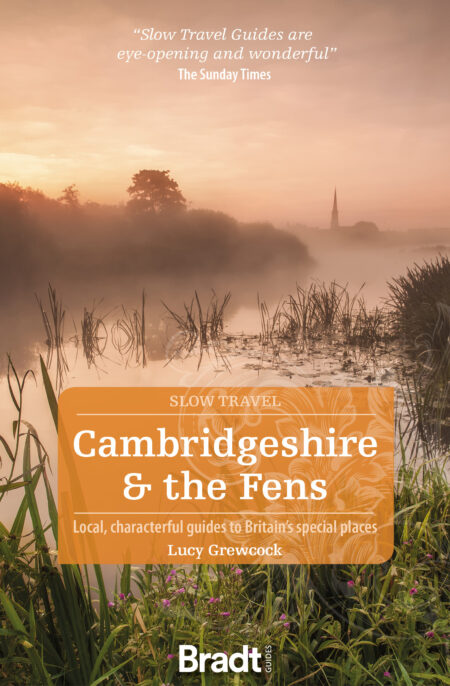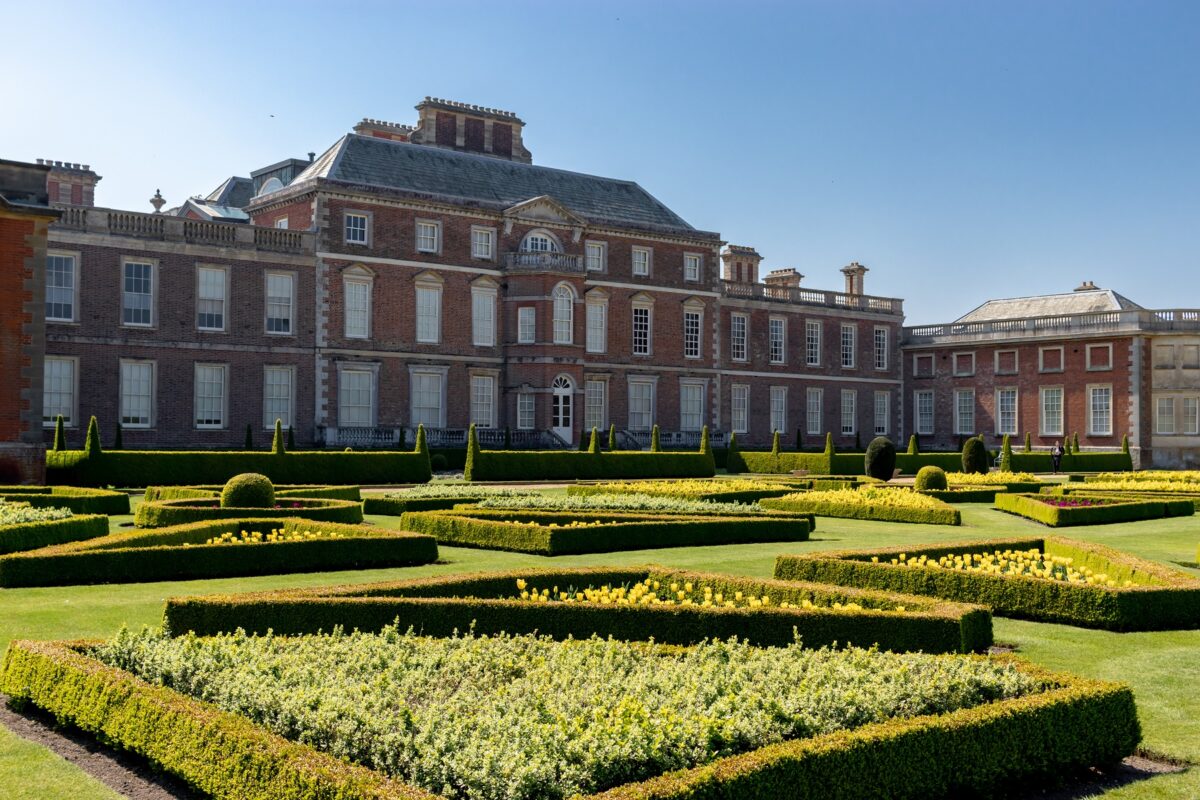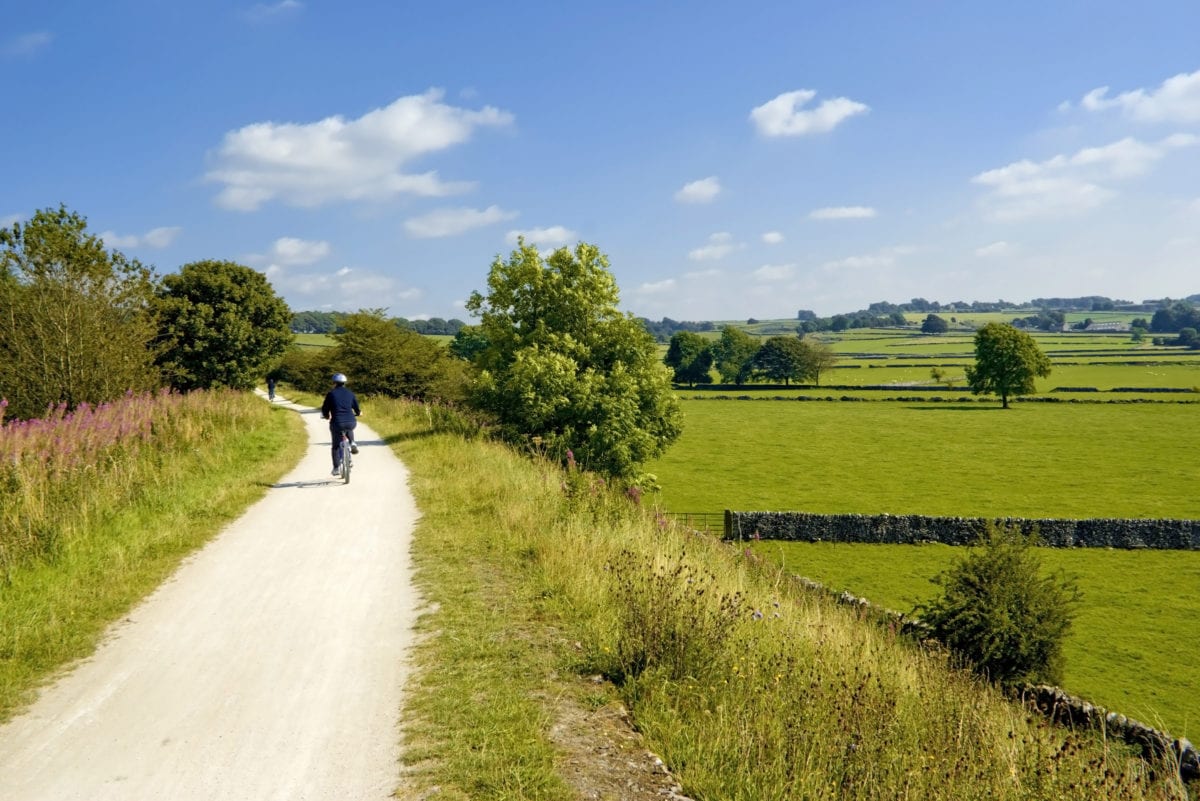By exploring slowly and delving into the stories and histories that have shaped these landscapes, you’ll start to get a true sense of Cambridgeshire beyond its capital.
Lucy Grewcock, author of Cambridgeshire & The Fens
Around 8.2 million visitors flock to the city of Cambridge each year but only a fraction stay overnight and very few venture beyond the city centre, let alone explore the rest of the county. By seeking out a backstreet pub or venturing beyond the county’s capital, Slow travellers can experience a side to Cambridgeshire that most visitors (and many residents, for that matter) never see.
If you’re fully committed to the Slow ethos, there’s far more to discover: linger longer or travel a little further and you’ll find Anglo-Saxon earthworks, wildlife-filled wetlands and historic villages that tell stories of the hermits and horse knockers, earls and adventurers, monks and millers, ice skaters and innovators that make this county so fascinating.
Shaped like a rough-edged diamond, every corner of Cambridgeshire exudes a different identity. In the southwest, the former county of Huntingdonshire is distinct in its riverside mills and market towns while, north of here, the city of Peterborough has a grand cathedral and is bordered by rolling countryside and honey-coloured villages that line the River Nene. In northeast Cambridgeshire, the pancake-flat fields, vast orchards and remote villages of the Fens feel a world away from the green hills and affluent settlements of southern Cambridgeshire, or the busy streets and grand university buildings of Cambridge itself. It is this diversity that makes the county so appealing to Slow travellers, who can experience vastly different landscapes, architecture and attitudes within just a few miles.
By exploring slowly and delving into the stories and histories that have shaped these landscapes, you’ll start to get a true sense of Cambridgeshire beyond its capital.
Bradt on Britain – our Slow Travel approach
Bradt’s coverage of Britain’s regions makes ‘Slow Travel’ its focus. To us, Slow Travel means ditching the tourist ticklists – deciding not to try to see ‘too much’ – and instead taking time to get properly under the skin of a special region. You don’t have to travel at a snail’s pace: you just have to allow yourself to savour the moment, appreciate the local differences that create a sense of place, and celebrate its food, people and traditions.
For more information, check out our guide to Cambridgeshire & the Fens
Food and drink in Cambridgeshire & the Fens
Cambridgeshire has no shortage of great pubs, restaurants, food shops and markets, many of which are champions of Slow food and drink – you can try homemade gin in Grantchester, local pies at Ely Market and buy freshly milled flour from Houghton Mill or Swaffham Prior.
Whatever delicacy you choose and wherever you decide to eat it, we guarantee the food scene in Cambridgeshire will not disappoint. Cambridgeshire has some of the world’s richest farmland, producing bountiful crops of everything from soft fruits to celery, while its restaurants, pubs and artisan markets showcase this produce at its best.
Food
Eel
Although the county isn’t well known for any particular dish these days, it was once the best place in England for eels, which were caught locally and jellied, stewed or baked in pies. Sadly, local eel stocks have plummeted in recent decades and this Cambridgeshire classic has faded from the regional diet. Nonetheless, it is fondly remembered in the city of Ely, which hosts eel-themed artworks and an annual Eel Fayre, while one restaurant – the Old Fire Engine House – still has eel on the menu.

Burnt cream
One local speciality to look out for is Cambridge burnt cream: similar to crème brûlée but with a thicker topping of burnt sugar, this decadent dessert was created at Trinity College in 1879 but is often overlooked in favour of its French counterpart. It can be found on the menu at Sheene Mill and at a couple of restaurants in Cambridge. Stilton cheese is another Cambridgeshire foodstuff that has a long history with the area – hailing from Stilton village, you can enjoy this stinky blue at The Bell Inn.
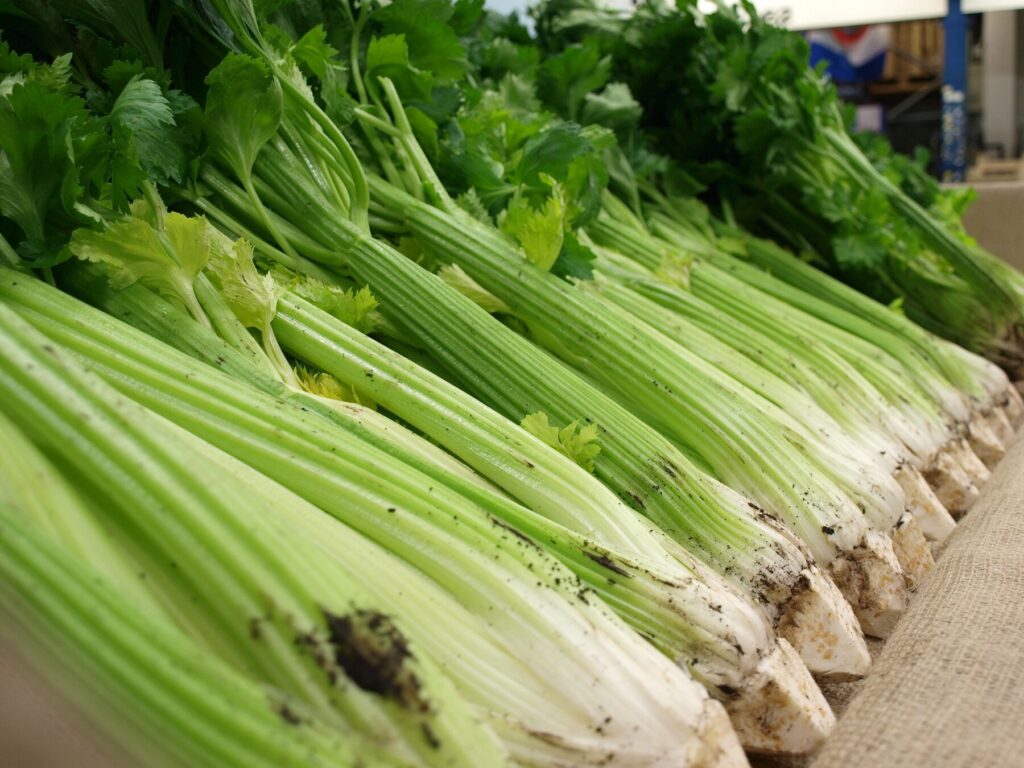
Fruit and veg
The best Cambridgeshire produce, however, comes fresh from the soil. Boasting some of the world’s richest farmland, the Fens produce a fifth of England’s potatoes, a third of our veg and some of the highest-yielding wheat crops on the planet.
Much of the UK’s celery is grown here and, in 2013, Fenland celery (a British heritage variety) was awarded protected geographical indication (PGI) status. Distinguished by its nutty, bittersweet flavour, this prized vegetable is only available between October and December – look for it in farm shops like Burwash Manor and Johnsons of Old Hurst, or at the farmers’ markets in Ely, St Ives and Cambridge.
Fruit also has a long association with the county. In the mid 19th century, orchards were a defining feature of Cambridgeshire life, with whole villages employed to work in the fruit-growing industry. Histon near Cambridge was home to a world-leading jam factory and is still an important jam-making hub today. Huge Bramley orchards were also planted in the Fens, where they’re still an important crop – you can see them by following the Apples & ale cycle route, which leads out into the countryside from Wisbech.
Drink
You’ll find locally produced ales on sale in most Cambridgeshire pubs, while micro-breweries like Wylde Sky Brewing welcomes drinkers to its tap rooms. For brewing on a larger scale, you could visit Elgood’s in Wisbech which has been making ale since the 1800s.
If cider’s more your thing, Simon’s Cider in Godmanchester uses salvaged local apples; if you’d prefer an afternoon quaffing wine, head to Chilford Hall Vineyard which produces award-winning reds, whites and rosés in one of the oldest-established vineyards in England.
Where to stay in Cambridgeshire & the Fens
For information about accommodation, see our list of the best places to stay in Cambridgeshire & the Fens
What to see and do in Cambridgeshire & the Fens
Cambridge
Cambridge is full of storybook scenes. From the ornate spires that rise above the River Cam, to the university scholars rattling down the cobbled backstreets on rusty old bikes, the city is a truly iconic part of Cambridgeshire.
Yet alongside these clichés, as wonderful as they are, Cambridge has many other layers that reveal themselves if you linger a little longer or delve a little deeper. From the haunted bookshop and ancient Leper Church to the cutting-edge technology of Silicon Fen and the backstreet boozers off Mill Road, seeking out these layers is the key to understanding this small city and experiencing more than a tick list of tourist spots.
Going slow in Cambridge is easy when you know how, with urban meadows to picnic in, riverside paths to ramble along and historic streets to explore on foot.
What to see and do in Cambridge
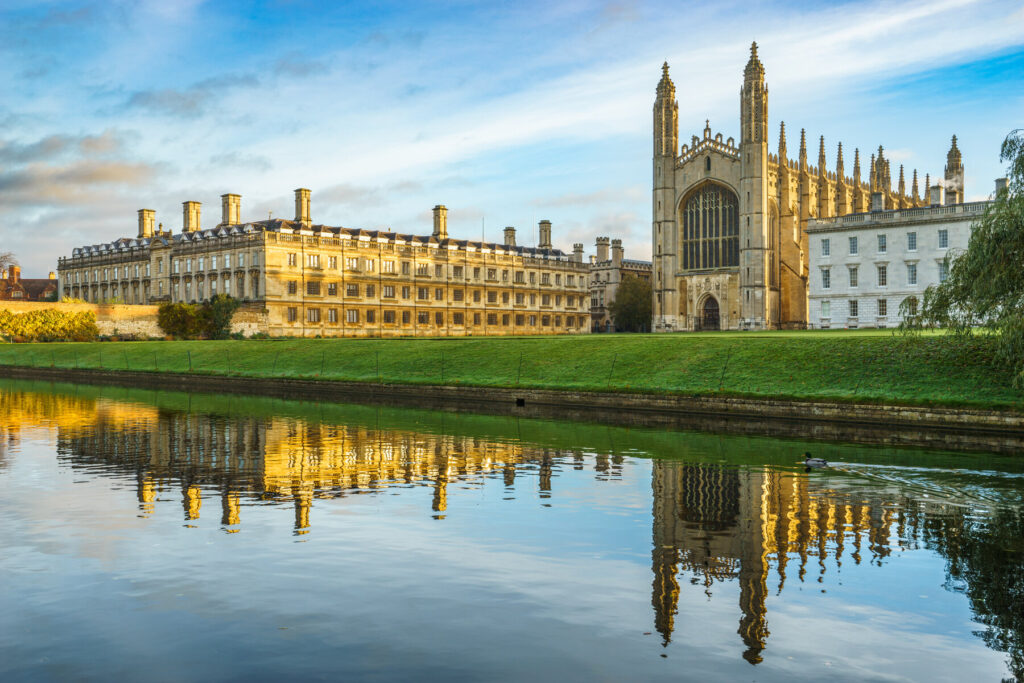
The university grounds
The University of Cambridge is made up of 31 autonomous colleges, which are scattered throughout the city. Having started life as religious institutions, many are several centuries old and have ornate chapels that are some of England’s finest.
Founded by King Henry VI in 1441, King’s College is both the most well-known and most impressive of the lot. Located on King’s Parade, the college chapel was built between 1446 and 1536 under the instruction of five different kings. Inside is Rubens’s Adoration of the Magi and the world’s largest fan-vaulted ceiling. To take a peek, you can join a guided tour or visit for evensong (17.30 Mon–Sat, 10.30 & 15.30 Sun) – queuing begins 35 minutes before each performance. Notable alumni include English cryptographer Alan Turing and Indian-British novelist Salman Rushdie.
While King’s College is undeniably the most impressive, there are many other colleges in Cambridge worth visiting. Wander down Senate House Passage (located on the right side of Senate House where the university’s graduation ceremonies take place) and veer left to meet Trinity Street. Here you’ll get a good view of Clare College, the university’s second oldest surviving college (founded 1326), where the naturalist David Attenborough studied zoology.
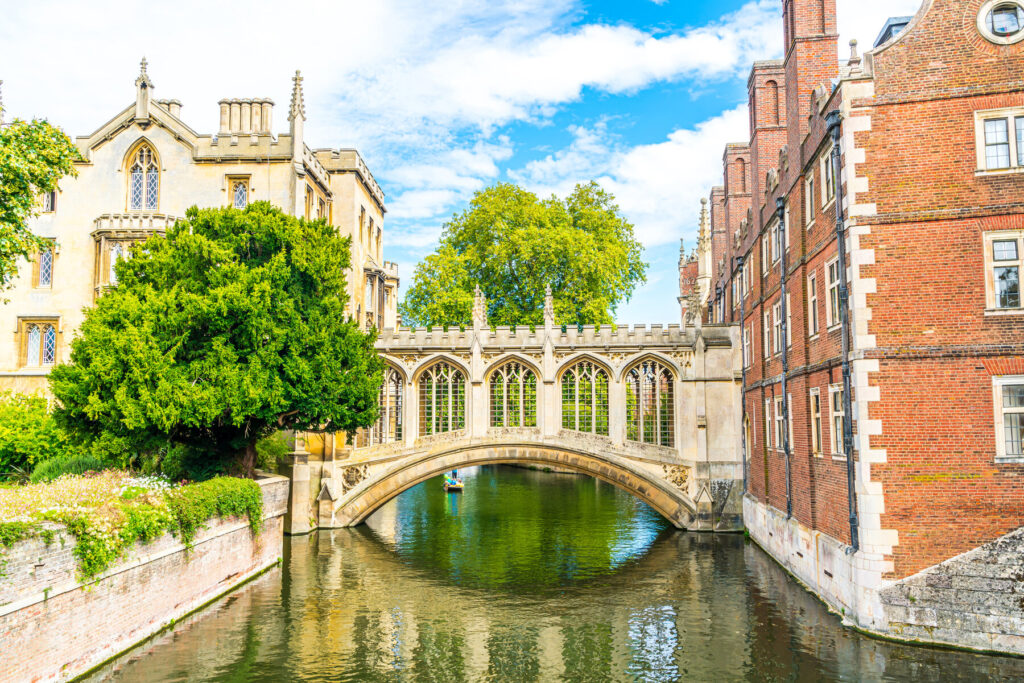
On the corner of Senate House Passage and Trinity Street is Gonville & Caius College (Caius is pronounced ‘keys’), where physicist Stephen Hawking studied. Further north on Trinity Street is Trinity College (1546), with its castle-like red- brick façade. Founded by Henry VIII, this is Cambridgeshire’s largest and wealthiest college, previously attended by Prince Charles, Lord Byron, Alfred Tennyson and Isaac Newton.
Look out for The Bridge of Sighs that spans the River Cam at St John’s College. This ornate river crossing is said to have been a favourite spot of Queen Victoria’s and is frequented by tourists looking to take the perfect riverside photograph.
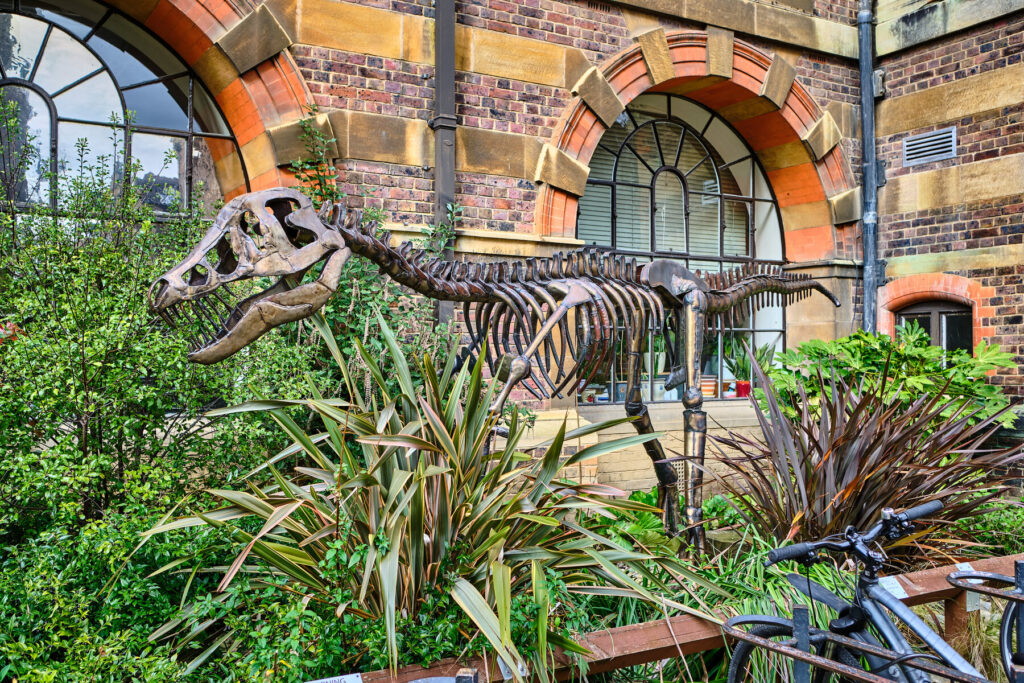
The Sedgwick Museum of Earth Sciences
The Sedgwick Museum of Earth Sciences is the University of Cambridge’s oldest museum. Established in 1728 as the Woodwardian Museum, it contains 4.5 billion years’ worth of earth science and is a must-see site for anyone with an interest in natural history.
Home to a collection of over 2 million fossils, minerals and rocks, a walk through Sedgwick is a journey through time, from the meteoritic building blocks of planets, to the thousands of fossils of animals and plants that illustrate the evolution of life in the oceans, on land and in the air.
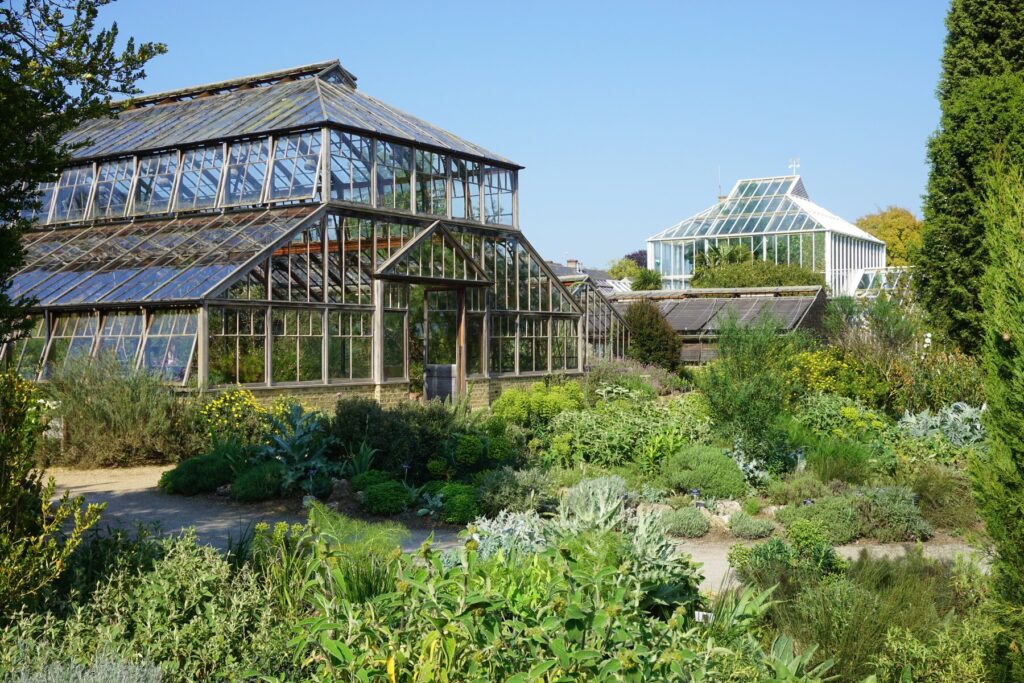
The Botanic Garden
Cambridge University Botanic Garden was initiated in the 1820s by Charles Darwin’s mentor, John Stevens Henslow, who convinced the university to move its original plant collection to a larger site, where it could be developed into a centre for learning.
Today the garden has around 8,000 plant and tree specimens in different zones that range from the woodland garden to the tropical hot house. You could follow the Main Walk past giant redwoods that were grown from the first seeds brought to England, or you could walk along the Rising Path and peer down on the historic Systematic Beds. You can also learn about everything from climate change and endangered plants to the first potatoes brought over from South America in Tudor times.
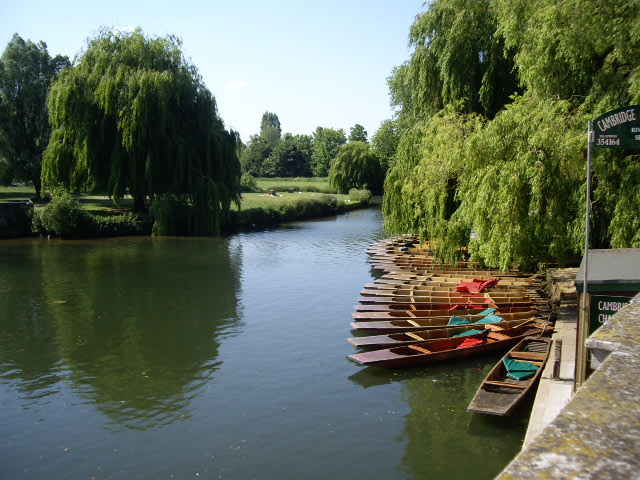
The Backs
When people talk about The Backs, they’re referring to a strip of land by the River Cam where six colleges (St John’s, Trinity, Trinity Hall, Clare, King’s and Queens’) back on to the banks. This riverside vantage point gives a whole different perspective of the university colleges, with their ancient buildings rising above the water and their landscaped grounds rolling down to the banks.
While it can be difficult to access the Backs without paying to enter the college grounds, there are a few places where you can glimpse this stretch of greenery on foot, without having to purchase entry. Silver Street Bridge (next to the Anchor pub on Silver St) allows you to gaze upstream to Queens’ College and Mathematical Bridge – designed by William Etheridge in the 1740s, this bridge follows a sophisticated design that makes it look as though it’s built from long pieces of timber but it is, in fact, made from lots of shorter pieces.
Further downstream, Garret Hostel Bridge (next to the Jerwood Library on Garret Hostel Ln), gives glorious views upstream to the grounds of Trinity Hall and the stone arches of Clare Bridge (part of Clare College), and downstream to Trinity College and Trinity Bridge. Set back from the river, the footpath that runs parallel to Queen’s Road gives a fantastic view of the back of King’s College.
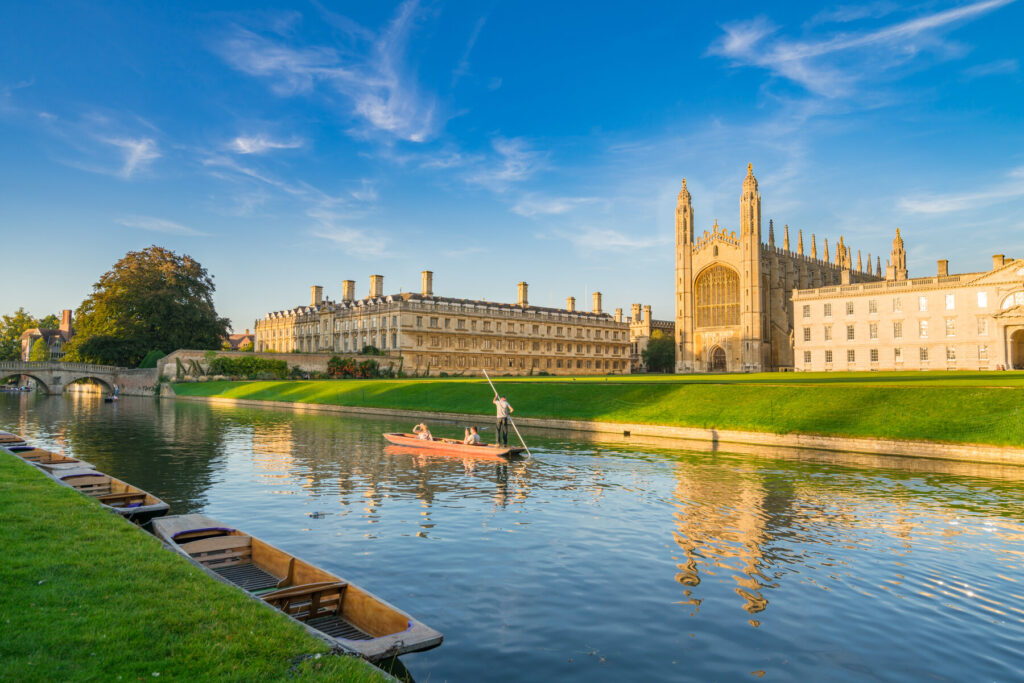
Punting
Punting along the Backs is a rite of passage, and the clunk and splash of punters is part of the city’s soundtrack. For anyone unfamiliar with the term, ‘punting’ involves propelling a flat-bottomed boat along the river, using a pole to push off the riverbed. Originally a means of transport, it was taken up as a leisure activity in the 1860s.
Cambridge and its surroundings lend themselves perfectly to explorations by river, with the river Cam meandering through Grantchester Meadows, into the city, and past Stourbridge Common to Fen Ditton and beyond.
If you fancy giving it a go, you could either hire a punt and steer yourself, or opt for a chauffeur (usually a university student) who will do the work for you. There are several places where you can hire punts, the most obvious spots being Magdalene Bridge and Silver Street Bridge – within a few feet of either location, you’ll be accosted by well-spoken students wearing deck shoes and waving clipboards, who will eagerly arrange your punt trip for you. You can also book in advance (try Cam Boats or Cambridge Boat Hire), which is a good idea on busy summer weekends.
Mill Road
A mile-long hub of hipster cafés, international restaurants and independent shops, Mill Road is the coolest corner of Cambridge.
Alongside the cafés and restaurants are eclectic shops offering everything from vintage clothes to organic meats. If you’re addicted to rummaging through charity shops for a hidden bargain, then this is the place to come – and if smashed avocados, flat whites and craft ales are among your favourite things, you should probably consider moving here.
Mill Road runs through two neighbourhoods: Petersfield (on the city centre side) and Romsey Town (southeast end). A bridge over the railway tracks marks the border between the two but the whole area is known collectively as Mill Road. There’s a real sense of community here, which is reflected in the busy calendar of local events, which includes music gigs, yoga classes and mental health talks in the cafés. Mill Road Winter Fair, one of Cambridge’s annual highlights, is held on the first Saturday in December when the road closes to traffic and becomes filled with food stalls, local crafts and open-air performances.
To delve deeper into the city’s bohemian vibes and finish your Cambridge weekend on a high, check out the impressive selection of live bands that play at the Corn Exchange.
Where to eat and drink in Cambridge
Vanderlyle This intimate restaurant allows its menu to be driven by the seasonal and ethical ingredients supplied by local farmers and producers, which means that many of the dishes are vegetarian. Book a seat at the pass and watch the chefs create your tasting menu of Cambridge salad, confit turnip and celeriac semifreddo, with each dish presented like a work of art.
Fitzbillies Founded in 1920, this cake shop and café is legendary for its Chelsea buns – actor Stephen Fry once described them as ‘peerless’. They have a second café on Bridge Street next to Magdalene Bridge and are the perfect spot to stock up on supplies for afternoon tea. Orders can be placed on their website.
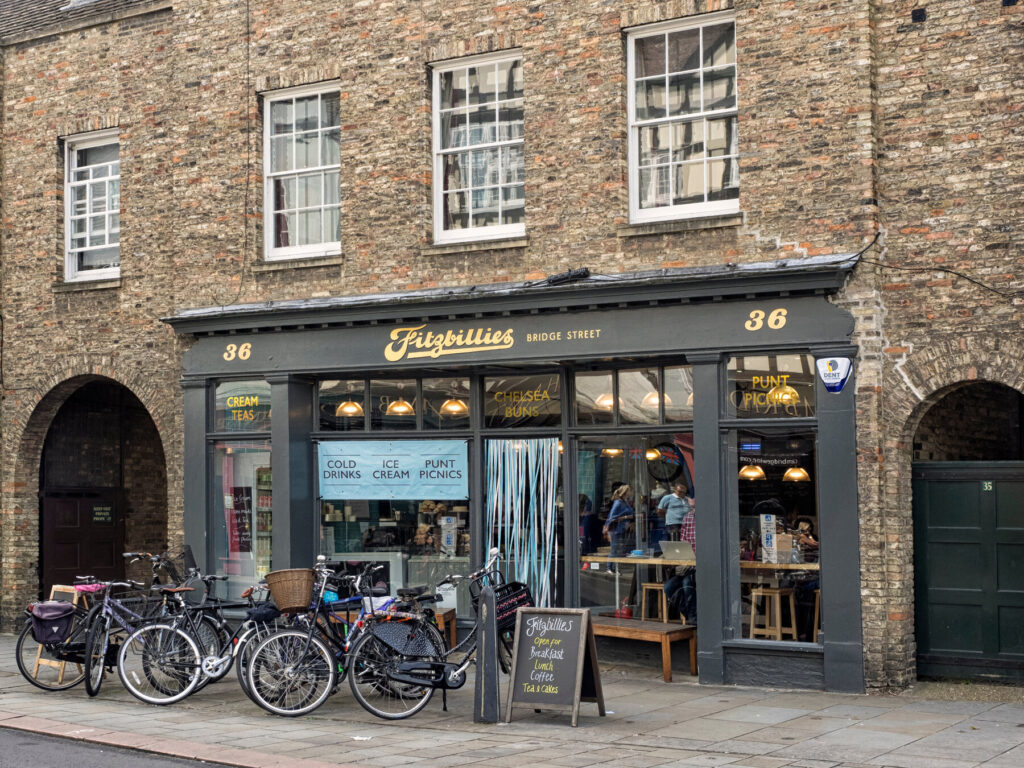
Cambridge Wine Merchants Named as one of the UK’s top 25 wine bars and best independent retailer, this wine shop and bar has one of the world’s largest collections of wines, spirits and cigars, including some from Cambridge colleges. Their Bridge Street premises sits by the river and has views of Magdalene College. They also have a shop and bar on King’s Parade.
Cambridge Market For take-away coffees, snacks and lunches, the stalls in the market place (open from 10.00–16.00 daily) are an excellent option, with hot food offered alongside artisanal breads and an array of delectable picnic items.
Ely
A matchbox-sized city with a big community vibe, Ely is the unsung gem of Cambridgeshire, with its showstopping cathedral, buzzing arts scene and laid-back river life. It’s only 15 minutes by train from Cambridge, yet far too few people make the trip here. Oliver Cromwell loved the city so much that he made it his home for more than a decade.
The story behind the city’s name is simple: when it was established on the Isle of Ely, the surrounding waters were writhing with eels, which were caught, sold and consumed in their thousands. Today, the river no longer wriggles with eels, at least not in the numbers that once thrived here, and the last commercial eel catcher hung up his traps in 2016. Nonetheless, the city stays true to its roots by celebrating ‘all things eel’ during the annual Eel Fayre.
What to see and do
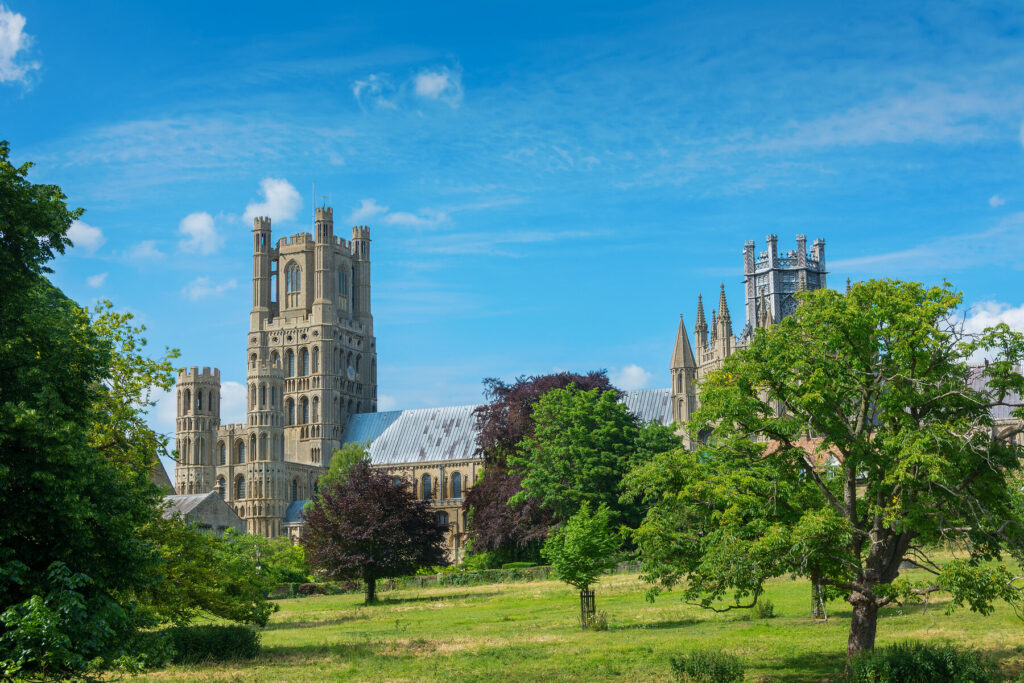
Ely Cathedral
With its 215ft tower visible for tens of miles across the Fens, Ely Cathedral – the ‘Ship of the Fens’ – is an iconic Cambridgeshire landmark and, up close, it’s even more magnificent. When you’re standing in the cathedral grounds it’s the intricacy of the stonework that strikes you – the cathedral’s vast, ornate façade will give you both neck cramp and eye strain as you try, in vain, to take it all in.
Once you’ve marvelled at the exterior, step through the Great West Door and Gothic Galilee Porch, and it’s the 245ft-long nave that first catches your breath, with its painted ceiling depicting the ancestry of Jesus. Beneath your feet are the patterned tiles of a Victorian labyrinth – follow its path and you’ll walk the same distance as the height of the West Tower, which rises above you. This is as far as you can get without paying the entrance fee, which is too steep for a quick nosey around.
To make the fee worthwhile, set aside at least half a day and take advantage of one of the inclusive hour-long guided tours. If you’d prefer to self-guide, the Ely Cathedral app has a choice of trails, including one for children. Your ticket gives all-day access, so you can always take a break for lunch and come back for more – not a bad idea, as there’s a colossal amount to digest here. It also pays to give yourself a head start with a bit of background into the history that hangs this epic piece of architecture together.
Outside, there’s more to discover. Home to England’s largest cluster of continuously inhabited monastic buildings, the grounds include the Prior’s House, the roofless 12th-century Infirmary and Prior Crauden’s 14th-century chapel – you can ask at the cathedral’s main desk for access to the last, which harbours wall paintings and the remains of a medieval tiled floor. To learn more about the cathedral grounds, ask for a map of the Monastic Trail or find it on the Ely Cathedral app.
Oliver Cromwell’s house
Doubling up as a tourist information centre and museum, this half-timbered building was once the home of Oliver Cromwell and his family, who moved to Ely in 1636 and stayed for ten years. Two of Cromwell’s nine children were born in this house and the youngest was baptised in St Mary’s Church, which you can see through the kitchen window.
Giving an immersive introduction to Cromwell’s life, the museum guides you through his story, from local MP to Lord Protector of the Commonwealth – King of England in all but name. As you progress through each room, kitted out with an audio guide, you’ll learn about Cromwell’s early life, how his family lived and what they cooked in the kitchen (note the recipe for Mrs Cromwell’s eel pie). Upstairs, kids can experience 17th-century Puritan life by trying on costumes and learning about medical treatments like leeches and unicorn horns. The last two rooms delve into the Civil War and track Cromwell’s rise through the ranks.
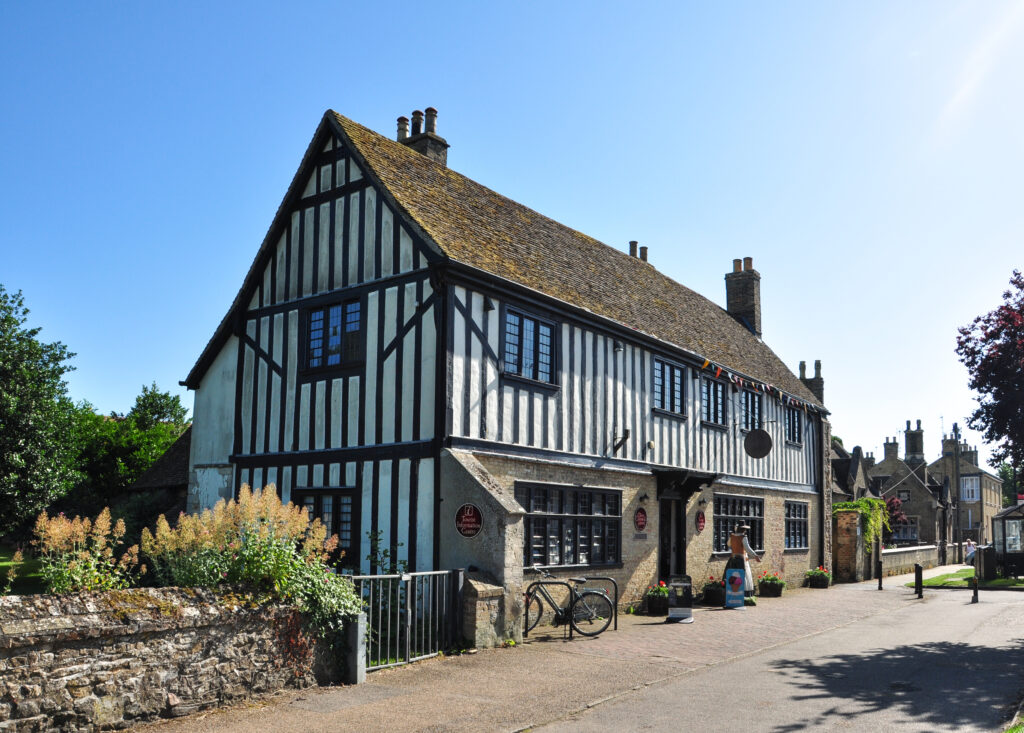
Ely Museum
Before the Fens were drained, the Isle of Ely was cut off from the mainland and ruled by a bishop who had the power to summon an army and lock up lawbreakers. The Bishop’s Prison, the Old Gaol, is now Ely Museum, which first opened in 1997. Between 2019 and 2021 it underwent a major renovation which transformed it into one of the most impressive local history museums I’ve seen anywhere. Alongside the exhibits, the fabric of the old building has been cleverly preserved, with an original fireplace and Tudor doorway, and prisoners’ names carved into sections of the old walls.
Roughly set out in chronological order, the exhibits start with the Fens’ earliest settlers and continue to Roman-era artefacts, which include fragments of Nene Valley Colour Coated Ware and a skeleton unearthed in the Fens. You can also learn about the history of Ely Cathedral and the story of the Littleport riots, while children can listen to folk stories in the video room. A timeline of fenland drainage is printed on the walls, and the museum’s second floor includes displays about prison life, contemporary fenland farming and more.
Getting around
Central Ely has two distinct areas: the city centre and the riverside. To explore both on foot, join one of the tourist information centre’s guided weekend walks. If you’d prefer to simply wander, you’ll find the Market Square and most of Ely’s shops and restaurants on the north side of the cathedral. Downhill of Market Square, the riverside is busy with boat life and has an arts centre, plus a handful of places to eat and drink. From here, you could take a boat trip with Liberty Belle, who offer regular half-hour tours (13.00–17.00 daily) – there’s no need to book, just turn up on the quayside near Waterside Antiques or The Maltings.
Grantchester
A couple of miles southwest of Cambridge, the leafy village of Grantchester is chocolate-box pretty, with thatched cottages and a honey-coloured church in keeping with the county’s iconic picturesque scenery.
On its eastern periphery, the Grantchester Meadows roll back from the river and are the perfect setting for picnics on the grass or wild swimming in the river, which is permitted (or ‘tolerated’) on this stretch. It’s worth mentioning that the river between Grantchester and Silver Street Bridge in Cambridge is sometimes called the Granta, although many people call it the Cam, and the two names are used interchangeably.
Along with its idyllic setting, Grantchester is known for its legacy of famous residents – current villagers include the sculptor Helaine Blumenfeld OBE and the novelist and former politician Jeffrey Archer. The village also claims the world’s highest concentration of Nobel Prize winners, thanks to the number of Cambridge academics who have lived here.
A charming High Street meanders through the village, which has the church of St Mary and St Andrew at its heart. The church is mostly 14th and 15th century, although some sections have been dated to 1100 AD. It acts as a mini tourist information point, displaying information about village life and its many claims to fame – Grantchester is the setting for the TV detective series Grantchester, and was also the subject of the Pink Floyd song Grantchester Meadows, which is based on band member David Gilmour’s experiences of growing up here. Cambridge University’s Corpus Christi College has been patron of the church since 1380 and you’ll find the college’s coat of arms – an image of a pelican pecking its breast – on the mosaic floor in front of the altar.
Grantchester’s most famous resident was the Edwardian poet Rupert Brooke (1887–1915). A graduate of King’s College, Brooke lived at Orchard House, and later at the Old Vicarage (where Jeffrey Archer now lives). He was part of the Grantchester Group – a community of artists and intellectuals that included economist John Maynard Keynes and novelists Virginia Woolf and E M Forster. The group would meet to discuss the arts, host parties and swim naked in Byron’s Pool. You can see original photos of Rupert Brooke at the Orchard Tea Garden.
Byron’s Pool
Less than a mile upstream from Grantchester is Byron’s Pool – the old mill pool where poet Lord Byron (1788–1824) bathed when he was a student at Trinity College. Rupert Brooke drew on Byron’s legend in his poem The Old Vicarage, Grantchester.
Still in the dawn lit waters cool
His ghostly Lordship swims his pool,
And tries the strokes, essays the tricks,
Long learnt on Hellespont, or Styx.The Old Vicarage, Grantchester (1912) by Rupert Brooke
It’s fair to say that the romance of the pool has faded somewhat over the years, thanks to the introduction of metal railings, a concrete weir and distant traffic noise from the M11. Nonetheless, it’s still a lovely spot, and the pool is surrounded by grassland, woods and riverside footpaths. As you wander, look for kingfishers and great spotted woodpeckers, a wealth of autumn fungi, or wildflowers, butterflies and damselflies in summer.
St Ives
There’s a lot to like about Cambridgeshire’s favourite ancient riverside town, from its unusual Bridge Chapel and the Old Riverport to the independent shops and historic Monday market. St Ives is a place to delve into Huntingdonshire history, potter around its shops and cafés, and soak up the Great Ouse views.
Originally known as ‘Slepe’, the settlement was renamed ‘St Ives’ in ad1001 when a ploughman discovered a stone coffin buried in a field. The Abbot of Ramsey Abbey (who happened to be the landlord) decided that the bones inside belonged to St Ivo, a Persian bishop. This announcement led to the founding of St Ivo’s Priory. Pilgrims came, the river was bridged and trade boomed. Before long, Ramsey Abbey’s biggest source of local income was the St Ives Fair: one of the four largest wool fairs in England.
While markets and fairs are still an important part of the town’s identity, all that remains of St Ivo’s Priory is the wall of a 14th-century barn on Priory Road – look for the information plaque on the old stone wall that skirts ‘The Priory’ office building.
What to see and do in St Ives
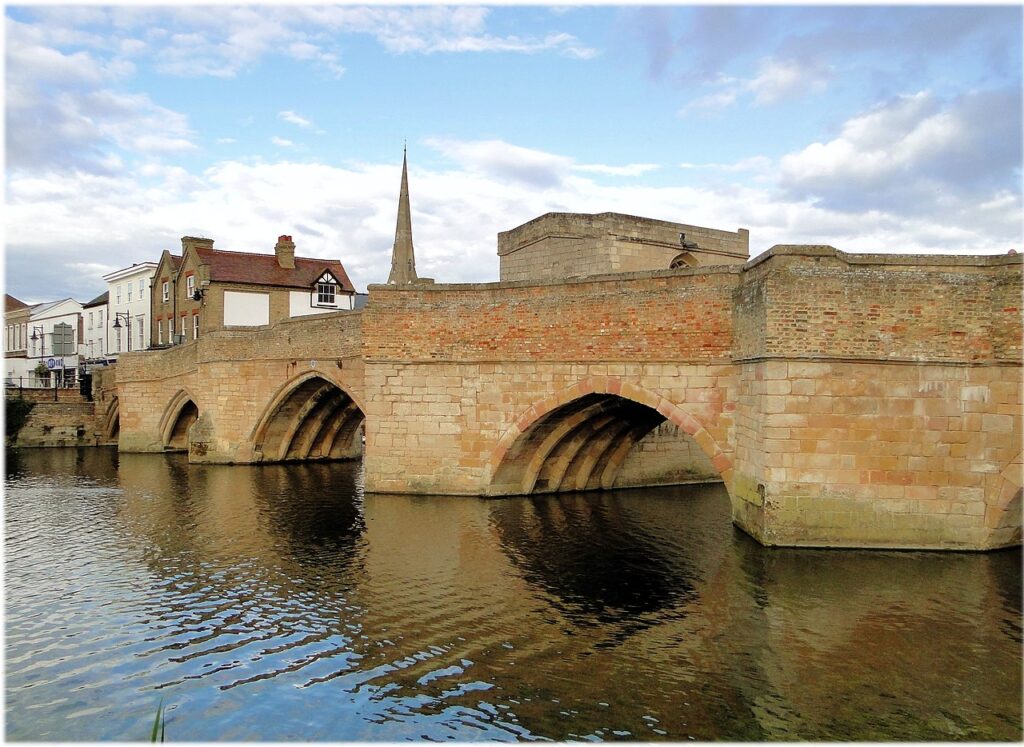
The Old Riverport
Before the development of railways and roads, the River Great Ouse was East Anglia’s major transport route, and St Ives was one of England’s busiest riverports. The Quay would have been a hive of activity, with merchant ships unloading their cargo, riverside inns bursting at the seams, and rows of barges and fen lighters (flat-bottomed boats) jostling for space, and young ‘horse-knocker’ boys tending the horses that pulled these flat-bottomed boats along the river. In 2014, in recognition of this rich heritage, St Ives officially named its town centre and quayside ‘The Old Riverport’.
Most of the Riverport’s shops and cafés are clustered along Market Hill and The Broadway. Once part of the medieval fairground and market site, this linear strip has a good dose of historical charm. Many of the grander buildings here were once busy coaching inns or the homes of prosperous millers and brewers.
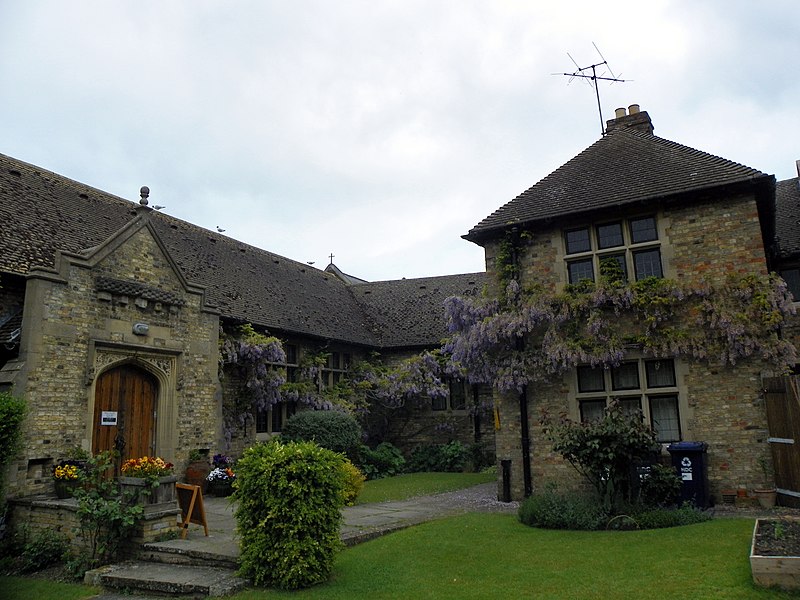
Norris Museum
At the far end of The Broadway is the excellent Norris Museum. Free to enter, the museum started life in 1933 as the natural history collection of St Ives local Herbert Ellis Norris and was reopened in 2017 after a £1 million revamp.
You can immerse yourself in an interactive pocket history of Huntingdonshire’s early days, told through Stone Age flint tools, 160-million-year-old Jurassic fossils, Roman pottery and Victorian relics. Some of Norris’s original collection is displayed in a recreation of his study, as well as a fantastic exhibit about the magic of fenland skating – listen to the video stories of Cambridgeshire locals skating under moonlight, and see an original ‘bandy’ stick and a pair of fen runners (ice skates).
Free Church
Looming over Market Hill, the Gothic-style Free Church (built 1863–64) is one of the oldest Nonconformist churches in England and was largely funded by Potto Brown of Houghton. Nip upstairs to appreciate the stunning worship space, or stay downstairs for the fair trade shop. Outside the church is an impressive bronze statue of Oliver Cromwell with a very stern gaze. Although Cromwell lived in St Ives for a while during the 1630s, the statue was originally intended for his hometown of Huntingdon. When Huntingdon failed to raise enough funds or local interest, St Ives stepped in – a reminder of the town’s history of nonconformity. Unveiled in 1901, the statue commemorates Cromwell’s 300th birthday.
St Ives market
In 1110, Henry I granted a royal charter for the St Ives Fair, which grew to become one of England’s largest. By the late 19th century however, things were getting out of control with the filth and mayhem caused by thousands of unruly beasts presented at market becoming a health hazard. As such, the historical market site is now home to the town’s main bus station but you can still see some of the metal bars from the old cattle pens. At the entrance is the town crest, which features four bulls’ heads – a reminder of just how significant the cattle markets were.
St Ives continues to host a weekly Monday market (beast free), plus a Friday market on Market Hill.
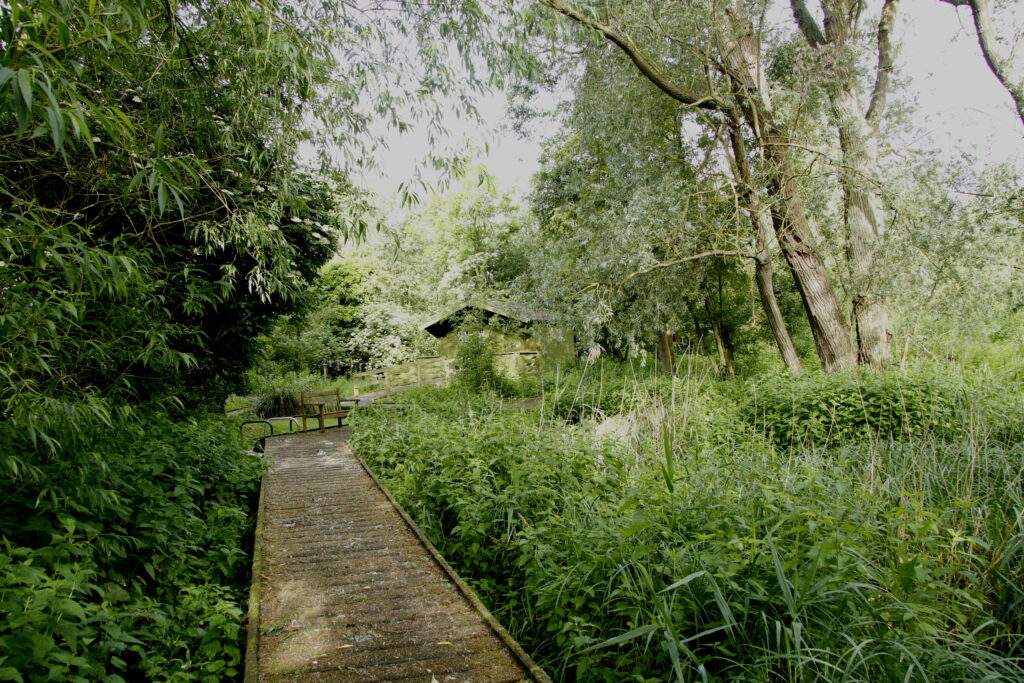
Holt Island Nature Reserve
A nine-acre river island, this secretive reserve is tucked away behind All Saints Church, to the west of the town centre. When the gate is unlocked, cross the footbridge and follow the raised boardwalks to discover wet woodland, reed beds and riverside wildlife.
This tranquil haven is home to warblers, herons, kingfishers, cormorants, badgers, foxes and more. If conditions are suitable out of season, the Norris Museum can give you a key.
The Cambridgeshire Fens
Home to England’s lowest point, the country’s biggest washland and some of the richest farmland in the world, there’s nowhere quite like the Cambridgeshire Fens. With vast fields, straightened rivers and a grid pattern of drainage channels, almost every inch of this landscape has been engineered to prevent it from flooding. Despite this, the Fens can feel wild in their remoteness, with huge flocks of birds and enormous skies where sunsets sizzle in cinematic intensity.
To understand the Fens, it’s essential to delve into the past – this was once the largest wetland in England, alive with croaking frogs, whispering reeds and screeching wildfowl. Rising a few feet above the swamps were low-lying islands where early settlers built villages on stilts, hermits sought solitude and towns like Ramsey grew around some of the wealthiest abbeys in England. The Cambridgeshire Fens also had a coastline – a ridge of higher ground to the west and south where settlements like Peterborough and Waterbeach developed along the fen edge.
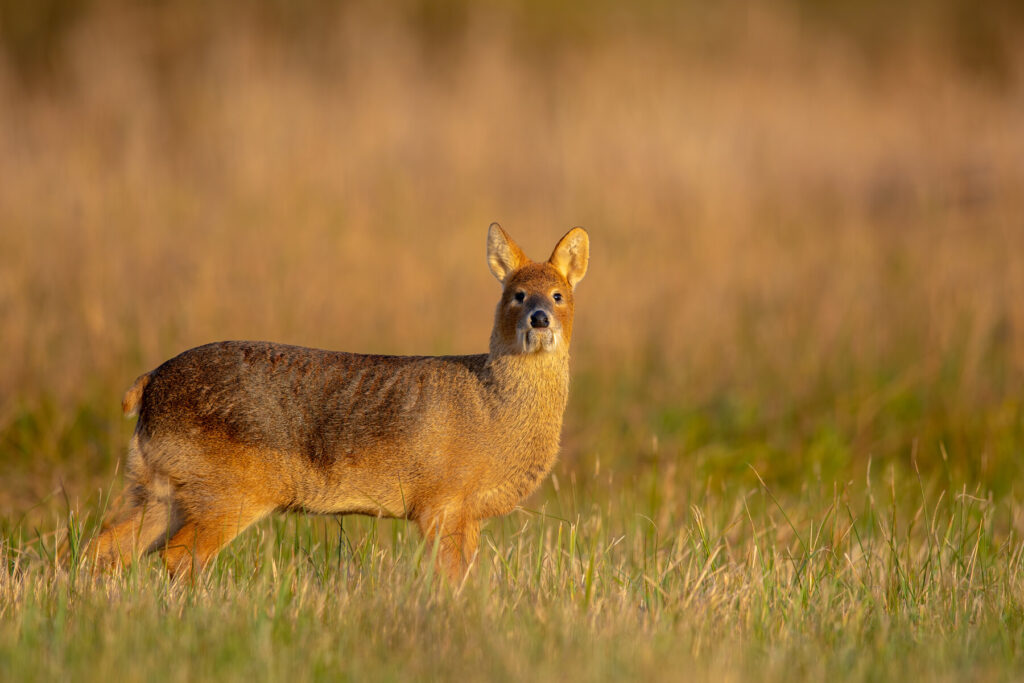
The people of the Fens lived in tune with their drowned world. They travelled using boats, stilts and ice skates; they built homes from reeds and mud; and they lived off eels, fish and wildfowl, using fertile patches of fen that dried out in summer to graze their livestock. But it was this fertile land, which lay submerged in water for much of the year, that sealed the fate of the wild fens. The great drainage operation began in the 17th century and hasn’t stopped since, transforming the swamps into vast swathes of productive agricultural land.
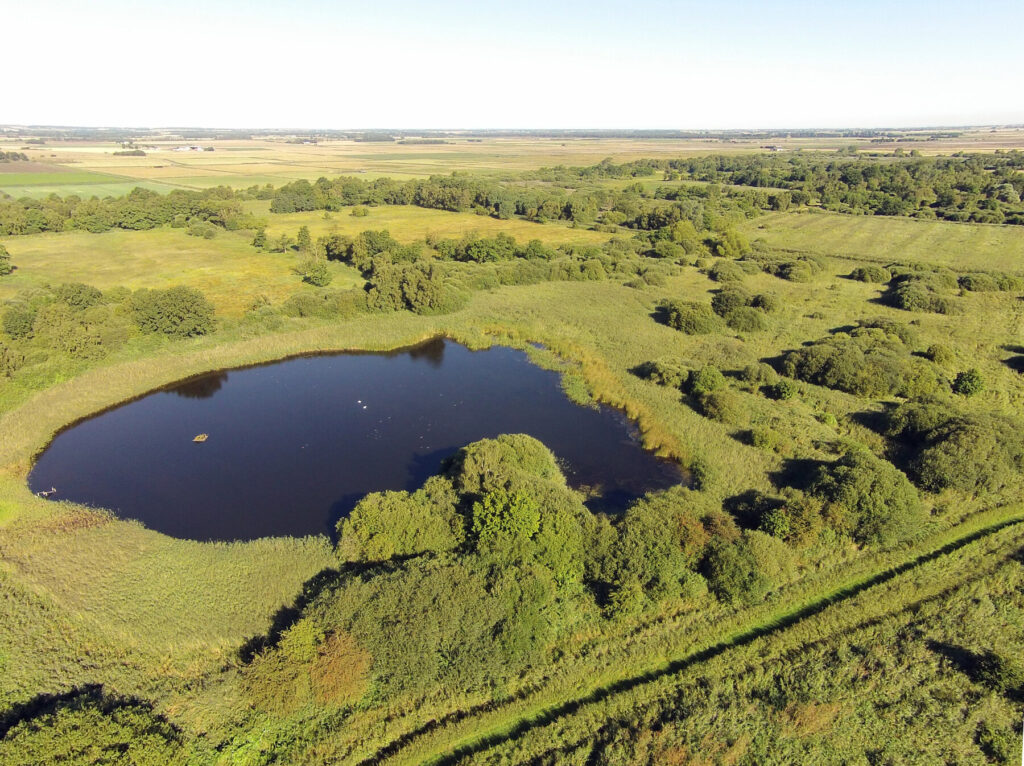
Great Fen
West of Ramsey is a collection of nature reserves that belong to one of the most ambitious conservation projects in Europe: Great Fen. This 50-year habitat restoration initiative aims to connect two of the UK’s last fragments of wild fen – Woodwalton Fen and Holme Fen – by restoring the degraded land between and around them. Once a watery world on the edge of Whittlesey Mere, this area was, along with the rest of the Fens, drained and transformed into an intensive agricultural landscape.
Although Holme Fen and Woodwalton Fen provide safe havens for fragile species, it is difficult for wildlife to thrive in such small and isolated reserves. Great Fen hopes to change this – the plan, which launched in 2001, is to link the two reserves by restoring 14 square miles of land between them.
Over the coming years, Great Fen will become a mosaic of wetland habitats that mimic the pre-drained fens. This restoration will also help to reduce peat loss, capture carbon, mitigate flood risks and encourage new economic opportunities that focus on tourism and the environment.
There are several different sites where you can experience Great Fen, all of which have mapped walking trails that you can download on greatfen.org.uk. You could also experience the Great Fen area at night – it’s a designated Dark Skies reserve, meaning low levels of light pollution often give clear views of the Milky Way.
Woodwalton Fen
The richest fragment of Great Fen, and one of England’s first-ever nature reserves, Woodwalton Fen gives a glimpse into the landscapes of the past. Bordered by drains and flood banks, it sits at the end of a lonely road and is surrounded by farmland that will, one day, become part of Great Fen. The reserve has an information stand and three marked trails but no other facilities. It’s worth mentioning that dogs are not allowed, even on leads.
Driving or cycling is the easiest way to get to this remote reserve, which has a small parking area beside Great Raveley Drain. Find a quiet spot within the reserve and you’ll be immersed in ancient fenland sounds – the whisper of grasses, buzzing of dragonflies and calls of waterbirds. Grassy paths lead around the site, and there are three meres with raised bird hides that beckon you to sit patiently and wait for the wildlife to emerge. Among the highlights are marsh harriers and common cranes, which disappeared from the Fens 400 years ago but recently returned. There’s also a chance of seeing water voles and Chinese water deer.
Holme Fen
Holme Fen is unlike anywhere else you’ll find in the Fens, or in Cambridgeshire for that matter. It’s the lowest point in Great Britain (around 9ft below sea level) and, according to Natural England, the ‘finest example of birch woodland in natural Britain’. There’s something utterly magical about the slender trunks and silvery bark of the trees, and the dappled sunlight filtering through the canopy to the forest floor, which boasts 500 species of fungi. And all this in the least-wooded area in the UK.
How then, did this 657-acre woodland come to be? It’s a story of natural succession: Holme Fen was once an area of reedy wetlands at the edge of Whittlesey Mere but as the lake was drained some of the surrounding land transformed into a raised bog, which became colonised by birch trees – the seeds of which are easily spread by the wind.
Within the woodland are the Holme Posts, which look like two big lamp posts sticking 13ft above the ground. These were the brainchild of William Wells – a local landowner who spearheaded the drainage of Whittlesey Mere. In 1848, Wells predicted that, when the lake was drained, the peat-rich soil left behind would shrink. To test his theory, he drove a timber post deep into the earth and cut the top off at ground level. Sure enough, the soil shrank away and the top few inches of the post were revealed – in these early years, the ground shrank as much as nine inches a year.
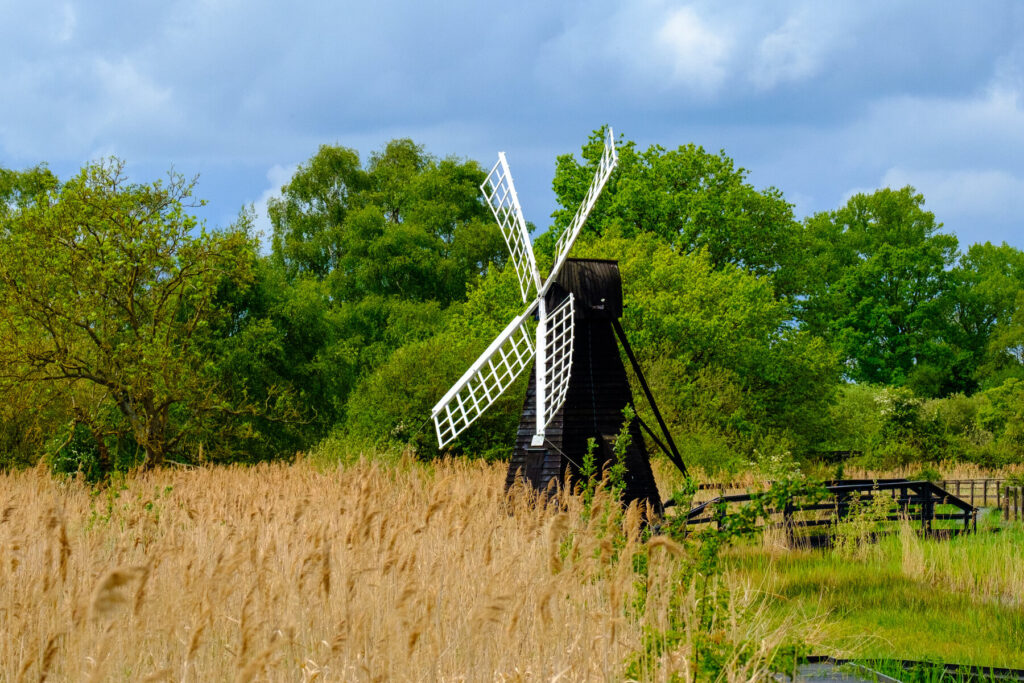
Wicken Fen
The National Trust’s oldest nature reserve, the initial two acres were bought from Charles Rothschild in 1899. Now spanning more than 1,975 acres, this is one of the few places where you can see, hear and feel what the pre-drained Fens may have been like – a landscape so rare that it’s internationally protected.
A mosaic of fenland, meadows, reed beds, waterways, meres and ditches, the reserve claims to have more species of flora and fauna than anywhere else in the UK. More than 9,300 different species have been documented here, from cranes, kingfishers, nightingales, bitterns, butterflies and otters to great crested newts, fen violets and the rare reed leopard moth. Some species are considered new to science or have never before been recorded in the UK, like the Silvanus recticollis beetle. To safeguard the survival of the reserve’s precious wildlife, plans are afoot to expand the reserve and extend the wildlife habitats towards the fringes of Cambridge.
A network of boardwalks leads through the wetlands and reed beds, with elevated bird hides gazing over a sea of golden grasses. Helping to sustain this landscape are herds of highland cattle and Konik ponies, plus a restored windpump, which was originally used for drainage. Ironically, it now pumps water back into the land to stop it drying out.
Southern Fen Edge
Before the Fens were drained, the fen edge was, in effect, the coastline of mainland England, with fenland swamps and islands to the northeast, and the uplands of Huntingdonshire to the southwest. The southwest edge sees the last of the River Great Ouse in full flow, before it diverts along the Bedford rivers. Here, the Great Ouse is flanked by birdlife-rich wetlands that form the southern extremity of the Ouse Washes – a chain of internationally important wetlands that stretches 25 miles northeast to Norfolk.
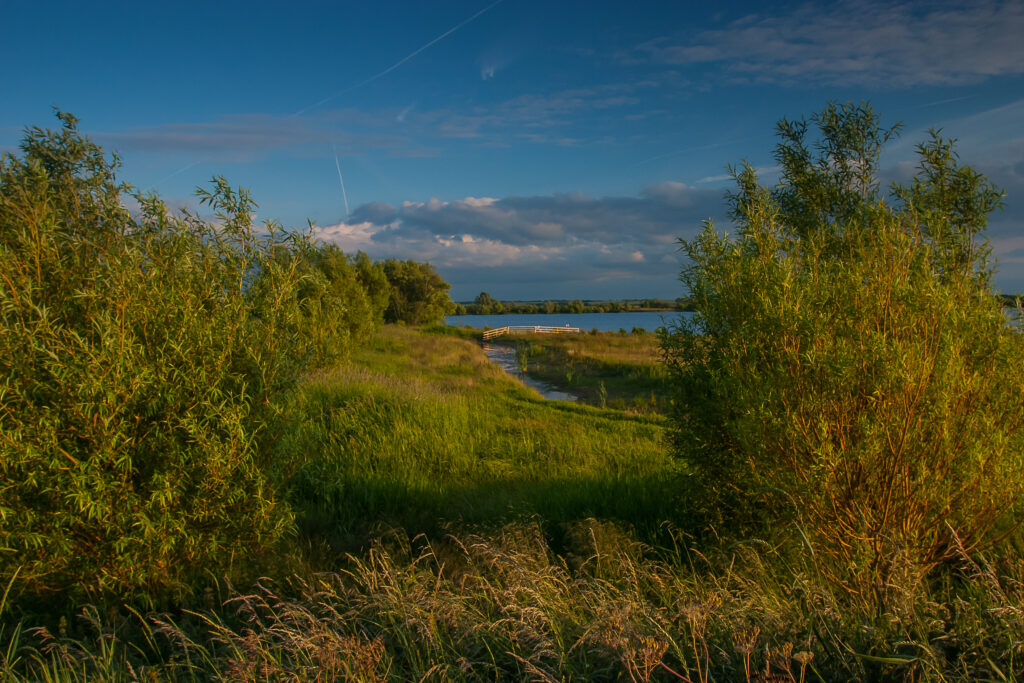
RSBP Fen Drayton Lakes
On the southern bank of the River Great Ouse, RSPB Fen Drayton Lakes is a master of the unexpected – don’t be surprised if a heron bursts out of the reeds, an orb of starlings performs a mesmerising dusk display, or a bus on rails glides past while you’re birdwatching. The reserve, with its network of lakes, sits at the far southwest end of the Ouse Washes wetland system. Habitats like this once covered vast areas of East Anglia, but by the mid 20th century the landscape had become an industrial one of sand and gravel pits.
It is now being returned to nature, with weed-dancing grebes, raft-nesting terns and acrobatic hobbies (small falcons) that dart above the water. Dragonflies and damselflies are prolific, with almost half of all UK species found here – to distinguish them, notice how dragonflies rest with their wings open, while smaller damselflies tend to close them.
Wimpole Hall
Cambridgeshire’s largest stately home is one of the county’s biggest draws. This working estate spans 3,000 acres, with a magnificent mansion, sprawling parkland, formal gardens and a rare-breeds farm.
There’s a vast amount to experience at Wimpole Hall – on first visit, it can take a good hour to simply stroll around the hall’s front garden and take in its mighty façade. Inside, there are sitting rooms, servant quarters and bedrooms galore. Highlights include a library with more than 6,000 books, and a dramatic drawing room that welcomed Queen Victoria in 1843. Don’t forget to look up at the ceilings – they’re incredibly ornate.
Behind the house, the Walled Garden features a bountiful orchard of plums, apricots, quince and more, plus a kitchen garden which grows 50 types of tomato that are showcased at the annual Tomato Festival (Sep). Much of this produce appears on the menu in Wimpole Hall’s café. Over at Home Farm, you can meet Longhorn cattle and white Bagot goats, and kids can pet the rabbits, have a go at milking on artificial udders or ride in a horse and carriage. Even the shops at Wimpole have a scenic setting – you’ll find the gift shop and garden shop in the 19th-century stable block.
The rest of the grounds are big enough to give you blisters as you explore the acres of parkland. Dogs are welcome and there’s a map by the stables with suggested routes, like the two-mile Folly Walk that leads to a striking Gothic structure. The network of cycle paths makes it easier to cover more ground, and the National Trust’s suggested routes range from the 1½-mile South Avenue Trail to the three-mile Victoria Drive woodland track and the four-mile Mare Way Challenge.
Entry costs to the Wimpole estate depend on which bits you want to experience – there’s a fee to enter the car park and mansion, plus an extra cost to visit the farm. Cyclists and ramblers without a car can enter the estate via the public path from Arrington village – look for the signs next to the stone gates, across the road from the bus stop.
Wisbech
Wisbech, the northernmost town in Cambridgeshire, is dubbed the ‘Capital of the Fens’. Lining the River Nene, it nestles against the Norfolk border, just a few miles south of Lincolnshire. It feels well off the beaten track but Slow travellers who venture to this outpost can look forward to some of the most impressive Georgian architecture in Britain, along with fascinating museums and memorials that honour the town’s inspirational former residents – the likes of anti-slavery campaigner Thomas Clarkson, philosopher William Godwin and social reformer Octavia Hill.
Central Wisbech has two distinct halves: the town centre with its marketplace and Georgian crescent, and the historic Brinks area, which overlooks the River Nene. These two areas are roughly separated by Town Bridge which, installed in 1931, was one of the UK’s first concrete bridges. For in-depth tours of these areas and a selection of fantastic walking tours, head to Visit Cambridgeshire or the National Trust.
What to see and do in Wisbech
Town centre
Angles Theatre
The Angles Theatre first opened in 1792 and is one of the oldest surviving Georgian theatre buildings in the country. As you face the theatre, the red-brick building on your left bears a blue plaque that marks the birthplace of journalist and political philosopher William Godwin, who was the founder of philosophical anarchism and the father of Frankenstein novelist Mary Shelley.
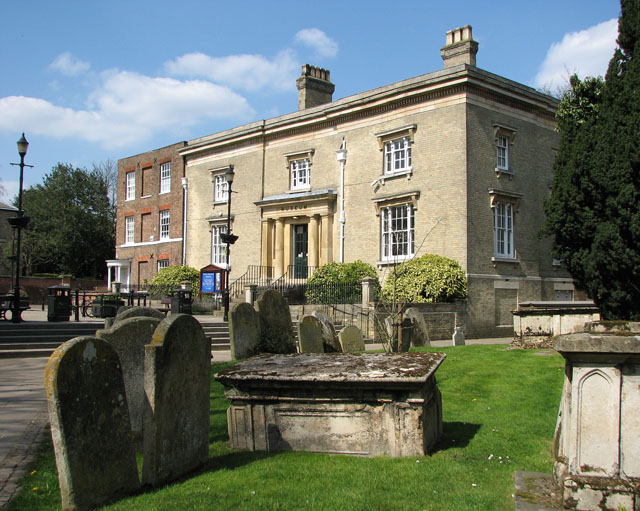
The Wisbech and Fenland Museum
The Wisbech & Fenland Museum opened its door in 1847. Focusing on fenland culture and Wisbech history, the museum is a charming example of a Victorian museum, with original display cases housing its eclectic collections. Photos and artefacts tell stories of fenland farming, drainage, crime and bygone crafts and trades, like peat digging, along with information about key town landmarks like Wisbech port and Angles Theatre.
You can also learn about famous residents like Thomas Clarkson – the museum displays the leg shackles, thumbscrews and branding irons that Clarksons’ collected in the 18th and 19th centuries to reveal the cruelty of the slave trade.
The Crescent
In the early 1800s, Joseph Medworth also built The Crescent – this circus of Georgian terraced houses which surrounds the manor is built within the Norman castle’s old moat. On the northeast side of The Crescent (between Union Pl and Ely Pl), Market Street leads to Market Place, where markets are still held seven days a week.
The Brinks
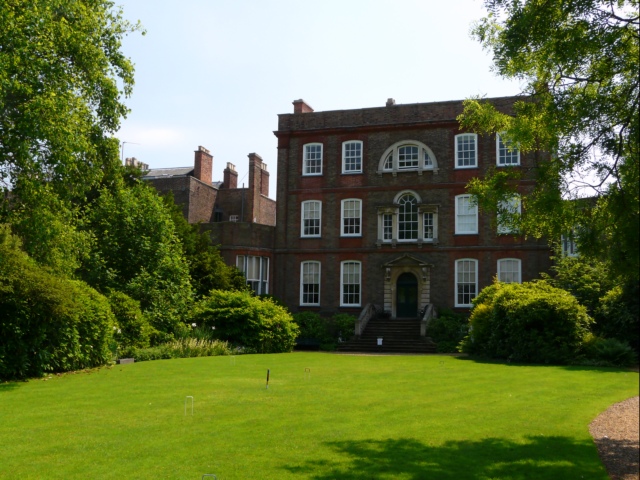
Peckover House
Set slightly back from the main strip of Georgian buildings, the standout landmark of the Brinks is the National Trust’s Peckover House. Built in 1722, this Georgian merchant’s house is testimony to the wealth of Wisbech in the 18th century.
For 150 years, it was home to the Peckovers – a Quaker banking family that played an important role in the history of the town. To explore the house, it’s best to book in advance on the National Trust website.
Octavia Hill’s Birthplace House
This volunteer-run museum was the birthplace of Octavia Hill (1838–1912) – a social reformer who co-founded the National Trust, campaigned to improve urban housing and fought hard to preserve open spaces. She believed in the importance of nature for well-being and wanted to improve the standard of living conditions for working-class people.
The museum has a pretty garden and 13 rooms, many of which have been decorated in an early Victorian style, typical of the era when Octavia Hill lived here (1830s/40s). The rooms tell the story of her life, her achievements and the people who influenced her.
Related books
For more information, see our guide to Cambridgeshire & the Fens:
Related articles
From medieval castles to Edwardian Arts-and-Crafts architecture.
Leave the car behind and explore Britain’s highways, byways and coastal pathways on two wheels.
